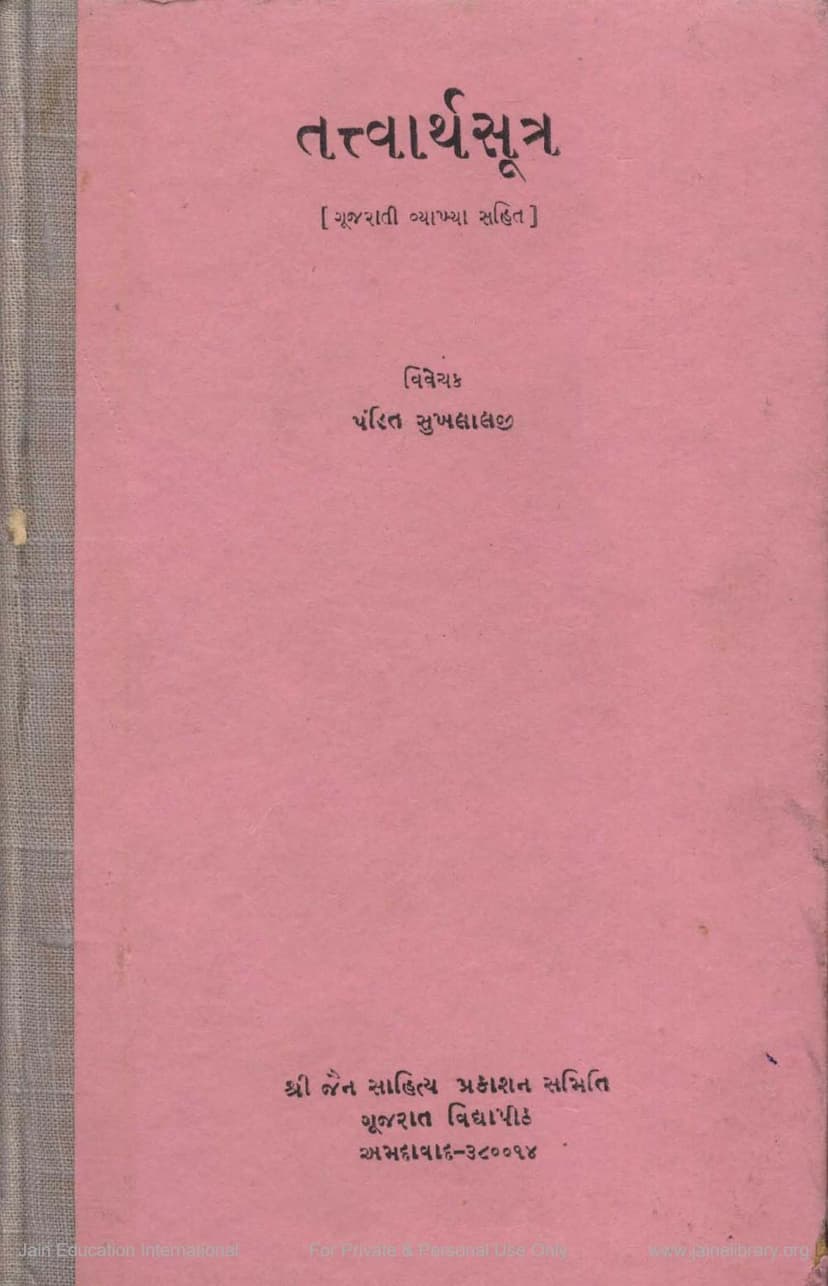Tattvartha Sutra
Added to library: September 2, 2025

Summary
The provided text is a Gujarati translation and commentary on the Tattvartha Sutra, a foundational Jain text authored by Umaswati (also known as Umaswami). The publication details indicate it was published by Jain Sahitya Prakashan Samiti, Gujarat Vidyapeeth, Ahmedabad, with Pandit Sukhlal Sanghavi as the critic.
Here'A comprehensive summary in English of the provided Jain text, Tattvartha Sutra, as presented in the given pages:
The Tattvartha Sutra, authored by Umaswati, is a seminal work in Jain philosophy and practice. The provided text includes the original Sutras, a Gujarati commentary by Pandit Sukhlal Sanghavi, and several introductory sections and appendices.
Core Jain Principles and the Path to Liberation:
The text begins by stating the fundamental Jain principle for liberation (Moksha): "Samydarshan, Samyagjnana, and Samyagcharitra (Right Faith, Right Knowledge, and Right Conduct) together constitute the path to Moksha." (Tattvartha Sutra 1.1)
This establishes the central theme of the Tattvartha Sutra: outlining the principles of Jainism that lead to liberation. The commentary by Pandit Sukhlal Sanghavi aims to make these complex philosophical and ethical concepts accessible.
Key Philosophical and Ethical Concepts:
The text delves into various aspects of Jain philosophy, including:
- Seven Tattvas (Realities): The core of Jain metaphysics, these are:
- Jiva: Soul or living being, characterized by consciousness.
- Ajiva: Non-living matter, encompassing space, time, dharma, adharma, and pudgala (matter).
- Asrava: Inflow of karmas into the soul due to passions and activities.
- Bandha: Bondage of the soul by karmas.
- Samvara: Cessation of karma inflow by controlling passions and activities.
- Nirjara: Shedding of accumulated karmas.
- Moksha: Liberation of the soul from all karmic bondage, leading to an eternal state of bliss and omniscience.
- Pramana and Naya: These are the means of valid knowledge and the various perspectives or standpoints used to understand reality. The text explains how right knowledge (Samyagjnana) is gained through these methods.
- Types of Knowledge (Jnana): The text details the five types of knowledge: Mati (sense knowledge), Shruta (scriptural knowledge), Avadhi (clairvoyance), Manahparyaya (telepathy), and Kevala (omniscience).
- Jiva and Ajiva: The fundamental distinction between living and non-living substances is elaborated upon.
- Cosmology: The text describes the structure of the universe, including the various realms, celestial bodies (sun, moon, stars), and the hellish realms (Narakas) and heavenly realms (Devas).
- Karma: A detailed explanation of karma, its inflow (asrava), bondage (bandha), causes (mithyatva, avirati, etc.), types (prakriti, sthiti, anubhava, pradesha), and the process of shedding it (nirjara). The text categorizes karmas into eight main types and their numerous permutations.
- Conduct (Charitra): The text outlines the path of right conduct, starting from the five vows (Ahimsa, Satya, Asteya, Brahmacharya, Aparigraha) and progressing through various stages of practice, including the eleven stages of observance (Goptis, Samitis, etc.) and the austerities (Tapas).
- Austerities (Tapas): Both external (Anashana, etc.) and internal (Prayashchitta, Vinaya, etc.) austerities are explained as crucial for shedding karma and progressing spiritually.
- Meditation (Dhyana): The text describes meditation as the concentration of the mind on a single object, crucial for spiritual progress. It outlines four types of meditation: Arta, Raudra, Dharma, and Shukla.
- Passions (Kashayas): The text identifies anger, pride, deceit, and greed as the primary passions that bind the soul and the need to overcome them for spiritual progress.
- Consequences of Actions: The text implicitly and explicitly discusses the consequences of actions (karma), explaining how different states of existence (hellish, animal, human, heavenly) and experiences (happiness, suffering) arise from past karmic actions.
Commentary and Scholarly Aspects:
Pandit Sukhlal Sanghavi's commentary is highly valued for its:
- Clarity and Accessibility: It aims to explain the profound concepts of the Tattvartha Sutra in a way that is understandable to both scholars and laypeople.
- Comparative Analysis: The commentary often draws comparisons with other Indian philosophical systems like Vedanta, Samkhya, Yoga, and Buddhism to highlight the unique tenets of Jainism and clarify its terminology.
- Historical and Textual Analysis: The introductory sections and appendices engage in detailed discussions about the authorship, historical context, and textual variations of the Tattvartha Sutra, examining different commentaries and traditions (Svetambara and Digambara). It also includes valuable insights into the historical development of Jain literature and thought.
- Detailed Indexing and Appendices: The inclusion of a detailed index (Anukramanika) and a glossary of technical terms (Pariibhashik Shabdkosh) makes the text highly useful for students of Jainism.
The Author and the Work:
The text highlights the significance of Umaswati as a scholar who compiled and systematized the vast knowledge of Jain Agamas in Sanskrit, making him a pivotal figure in the history of Jain literature. The introduction by the publishers and the author's own statements (Panch Sukhlalji nu Vaktavya) trace the long and complex journey of the Tattvartha Sutra's creation and multiple editions, emphasizing its enduring popularity and usefulness for spiritual aspirants.
Overall Purpose:
The Tattvartha Sutra, through its Sutras and this comprehensive commentary, serves as a guide to understanding the fundamental principles of Jainism, the nature of reality, the path to liberation, and the ethical conduct required for spiritual progress. It is considered an indispensable text for anyone seeking a systematic and thorough understanding of the Jain path to ultimate freedom.